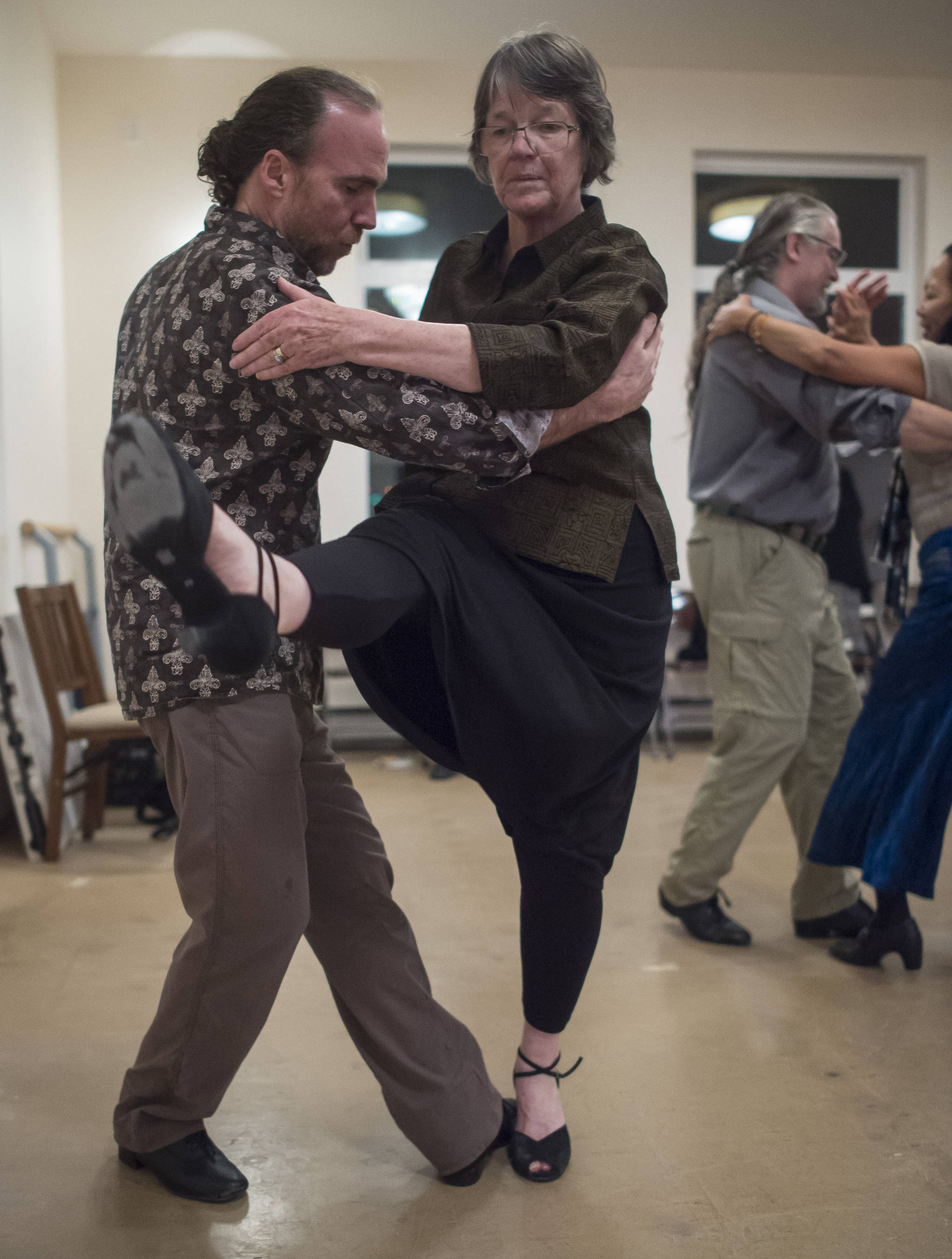Deciding to go to an Argentine Tango dance night when you possess the rhythm and grace of a Steller sea lion was nerve racking, but I figured, “Hey, it’s a new year.”
My reflection greeted me in wall-to-floor mirrors along with studio co-owner Lorinda Kassner, as I nervously walked into the Channel Dance Studio, which overlooks Gastineau Channel.
Kassner immediately reminded me of my favorite aunts, she greeted me warmly and offered me wine. I felt almost confident enough to dance.
Since I had arrived 15 minutes early, out of fear of dancing alone, Kasser gave me the rundown.
Tango Thursdays is a regular dance night which started three years ago at the dance studio. It’s organized by Tango Juneau, a group whose collective passion is to share Argentine Tango.
The class is not actually an instructive class led by an instructor, but rather just a set time and place for people — experienced and not — to dance the Argentine tango.
“Argentine Tango is an interpretive, improvisational social dance that allows dancers to develop a deep connection between themselves, the music, and the environment in which they are dancing,” she said.
Great, three things I was scared of: improvisation, dancing, and deep connection.
Entering the studio for the first time was intimidating, but being greeted by such enthusiastic and welcoming people made the task a bit easier to swallow. For those who are brand new, like myself, different dancers take you under their wings and give small tips and suggestions. I was swept up by local instructor Pat Belec, who taught me something I thought I already knew how to do: how to walk.
In Argentine Tango, a major component of the dance is walking. It’s not just regular walking, though, it’s a slide walk. Her demonstration was similar to Michael Jackson’s moonwalk. Later, a dancer told me that a visiting instructor taught him the moonwalk to strengthen his basic tango walks.
“You want to slide the pads of your feet across the floor, so they almost never leave the ground,” Belec instructed me. Thinking I was being clever, I brought my shortest heels; but alas, they had a grip bottom, hindering my ability to slide.
Belec and her husband Frank Bergstrom have been a part of the Argentine Tango scene in Juneau since the beginning, almost 17 years ago. The group consists of some 25 active members, she said, who either attend Tango Thursdays and also travel to dancing festivals down south.
Together the couple has learned from professionals all over the country. They also bring instructors from places down south, such as Seattle and New York, up to Juneau to host workshops.
“Tango is — at heart — a connection,” Bergstrom said. “Tango is at least the penultimate form of diplomacy. Tango transgresses differences for as long as the couple is on the floor. Dance partners are an interplay of intimacy, decorum, and universal communication. Hard to believe until you begin to master the art.”
As I watched the pairs of dancers throughout the night — there were about five or six in the studio — it became clear to me that Argentine Tango is a slow conversation between bodies; dancers engage in different conversations which is illustrated by their footwork, speed, and closeness.
Dancer Amy Liu’s effortless grace on the dance floor was especially envious, her feet softly moving and reacting to her partner’s direction. She gently would kick her heels or twist her hips to meet her partner.
Lui, a 24-year-old city employee, has been coming to the regular dance nights since September after moving to Juneau from Anchorage. She said tango dancing helps beat the dark winter days.
“I love to dance and I really rely on community activities to stay active,” she said.
While I was envious of her dancing abilities, I reminded myself that while she did start dancing in Juneau four months ago, she has been dancing for four years.
Cartographer Dave Albert, 50, has been a part of Tango Juneau for six years but really started to get hooked a year and a half ago.
“I just got back from an [Argentine Tango] festival and have been traveling to different festivals around the country,” he said. He has also danced in places like Portland, Seattle, Tucson, and even London.
Albert said a common misconception is that it is like what people see on Dancing With the Stars, but it is not competitive.
“This dance is unlike any other dance,” he said. “It’s complicated, intimate, and deep.” Albert added, “It is like improvisation jazz, there is no formula.”
When Albert travels, he evokes a common response.
“People are often shocked to hear there is a dance community in Juneau,” he said. “We are small but we are here.”
After getting over awkward self-consciousness, I followed my leads by looking at my dance partners’ chests, and mimicking their motions on the floor. The barridas (foot drag) and molinetes (circular grapevine) became instinctive by the end of the evening.
Leaving the studio the first night I felt a sense of pride. I had tried something new and was in a field that usually made me uncomfortable, but I was told I was a natural. I don’t know about that, but at least I didn’t fall.
KNOW &GO
For those who have never done sacadas, barridas, or boleos (all Argentine Tango moves), Tango Thursdays will be offering free beginners workshops at Channel Dance Studio, 2686 Channel Vista Dr., starting Jan. 11 at 6:30 p.m. to 7:30 p.m. followed by the usual open dancing until 9 p.m.
For more information, email Pat Belec at thedanceloft@gci.net or go to the group’s Facebook page at https://www.facebook.com/tangojuneau/.
• Erin Laughlin is a student journalist at the University of Alaska Southeast. She can be reached at laugerin@me.com.

